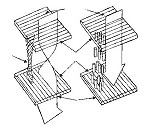Liquid Crystal Displays
These displays rely on the special characteristics of a group of Chemicals called Liquid Crystals (L.C.). Liquid Crystals are transparent and their molecules are twisted. The twist on the molecules transforms the polarisation of passing light. LCD's also re-align when subjected to an electric field. These characteristics are exploited to develop displays that use the crystals to control the amount of light passing through the display. Light is produced by a backlight and is passed through a polarizing filter.
 When
no field is applied to the LCD, the polarisation of the light is changed
by passing through the LC material. The light passes through a second polarising
filter set at right angles to the first and the light is transmitted.
If a field is applied to the crystal, the angle of twist changes, and only
a portion of light is transmitted. In this way the brightness can be
adjusted to achieve the grey scale necessary for high quality images. When
no field is applied to the LCD, the polarisation of the light is changed
by passing through the LC material. The light passes through a second polarising
filter set at right angles to the first and the light is transmitted.
If a field is applied to the crystal, the angle of twist changes, and only
a portion of light is transmitted. In this way the brightness can be
adjusted to achieve the grey scale necessary for high quality images.
The
screen is divided up into picture elements or pixels. The image is built up by making
use of these pixels. In a colour LCD, each pixel is fitted with either
a red, green of blue filter. The image is then made up of a matrix of pixels.
The method of controlling brightness in each individual pixel, known as
the addressing, is the key difference between the two types of LCD. The two LCD's are referred to as Active and Passive Matrix.
|